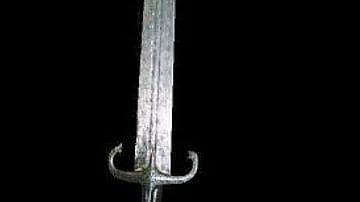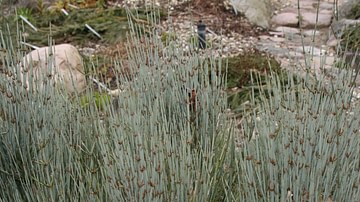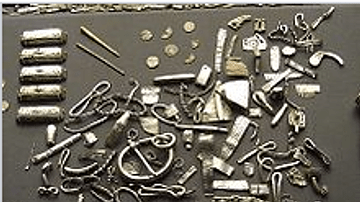Search Images
Browse Content (p. 844)

Image
Sword of Umar
A sword of Umar ibn al-Khattab (r. 634-644 CE). Made c. 7th Century CE, although the hilt is a later addition.

Image
Calligraphy of Ali's Name
A beautified calligraphic rendition of the name of Ali, the fourth Rashidun Caliph (r. 656-661 CE).

Image
Calligraphy of Uthman's Name
A beautified calligraphic name of Uthman ibn Affan (r. 644-656 CE).

Image
Illustration of the battle of Yarmouk (636 CE)
Illustration of the Battle of Yarmouk (636) at the bottom of the page of an early 14th Century CE manuscript. The forces of the Rashidun Caliphate are shown with a star and crescent banner, while the Byzantines are depicted with a star banner...

Image
Calligraphy of Umar's name
A beautified calligraphic name of Umar ibn al-Khattab (r. 634-644 CE).

Image
Khalid ibn al-Walid's Campaign in Arabia
Map detailing the route of the conquest of central Arabia by Khalid ibn al-Walid (585 - 642 CE) during the Ridda Wars, culminating in the decisive battle of Yamama (633 CE). Battles are shown as crossed swords (or scimitars) and the Rashidun...

Image
Rashidun Caliphate Under Caliph Abu Bakr
A map showing the Rashidun Caliphate (highlighted in green) by the end of Abu Bakr's (r. 632 - 634 CE) life in 634 CE.

Image
Ephedra Intermedia
Species of the genus ephedra, native to Iran. The plant haoma is thought to be of the genus ephedra (though this is contested) and was pressed for its juice which was then consumed to produce an altered, elevated, state of consciousness...

Image
North Africa After the Berber Revolt (739-743 CE)
Northwest Africa after 743 CE, when the Umayyad Caliphate had been overthrown in the region by the Berber Revolt of 739 - 743 CE.

Image
Cuerdale Hoard
The Cuerdale Hoard is one of the largest found Viking hordes containing over 8,000 pieces of Viking jewelry, bullion, and coins. It was discovered 15 May 1840 CE in the Ribble Valley, a once bustling route for Vikings travelling between the...